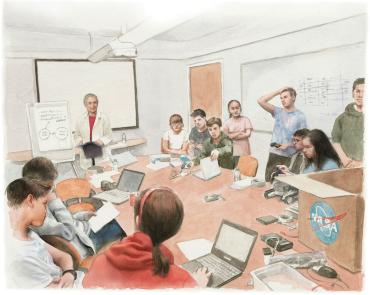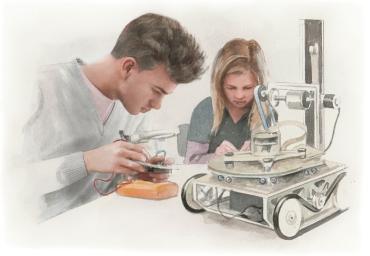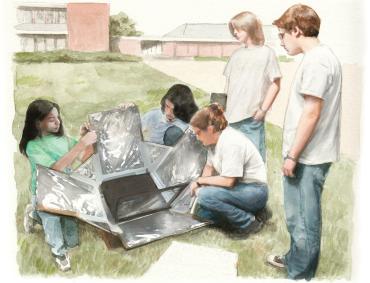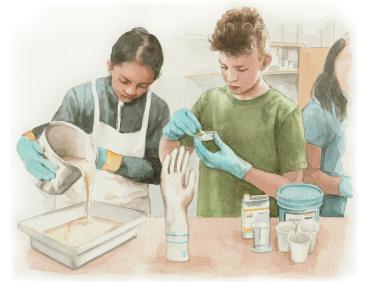Another school year draws to a close. You sit at a faculty meeting and the principal declares that all science instruction will need to be NGSS-aligned next year. The state has officially adopted the Next Generation Science Standards (NGSS). You knew this change was coming, yet you’ve been dreading it. A colleague leans over and says, “What are you going to do about the NGSS? I’ll probably just use the same lessons I’ve used for years. I’m sure I can find the practices in there somewhere.” You think to yourself, “Yeah… my students already do hands-on activities, and they really seem to like science. I ask them lots of questions. How much will my teaching really need to change?”
Not everyone at your school is familiar with these new standards, so your principal explains they are based on A Framework for K–12 Science Education, a report developed by the National Research Council.1 Scientists, educators, education researchers, and engineers from 26 states wrote and reviewed the standards, which were published in 2013. Yours is one of 19 states that have adopted them to prepare students for college, careers, and citizenship by specifying the expectations and goals for learning. The standards, she says, will provide your school and district with a foundation to make coordinated decisions around curriculum, assessments, and instruction, from kindergarten through twelfth grade, across the life sciences, the physical sciences, the earth and space sciences, engineering, technology, and the application of science.
Your principal says that to help make the transition, she’s arranged for a tour of a neighboring school where some of the science teachers have already started implementing the NGSS.
You’ve been given a release day to visit and observe two standards-based classrooms teaching the same scientific concept. You notice the following:
| Classroom 1 | Classroom 2 | |
| You hear the teacher say... |
“Who can tell me the three ways that heat can be transferred between two objects?” “Before you can begin, you’ll need to tell me what you think will happen in this lab based on the chapter reading and lab protocol. If you haven’t done the reading on thermal energy, then how will you know if your results match what is expected?” “What did you learn about thermal energy from doing this lab?” “In a diagram, draw how the energy flows when a hot object touches a cold object.” |
“How do we design a device that can bake cookies using only the sun’s energy?” “We’ve all reviewed the chapter on thermal energy, but before you can begin your investigation, you need to explain what you are trying to figure out. What do you still need to consider as you design your cooking device?” “How has this lab informed the design of your thermal device?” “Develop a model that explains how your device will use energy from the sun to bake your cookies.” |
|
You overhear students saying... |
“Of course I took notes! I wrote it all down because I know this is probably going to be on the test.” “This was so cool. We got exactly what it says in the book!” “This is so frustrating. Just tell me what I need to know!” “What are we up to? We’re learning about the different types of thermal energy.” |
“Let me see if something in my notebook will help us figure out why the cookies aren’t getting warm.” “Aha, so that’s how it works! Now I see how we can change our design.” “This is so frustrating. I’ll need to try something else.” “What are we up to? We’re figuring out how to use thermal energy from the sun to bake these cookies.” |
You thank both teachers, and before talking with your colleagues, you begin to wonder to yourself: “In my own teaching, do I hear more things like the first classroom or the second? What am I trying to get my students to do? How would my kids describe what they are up to in my class?”
The Next Generation Science Standards provide a framework for shifting instruction toward what you see in Classroom 2.2 The new standards ask teachers to support student learning through the application of “Science and Engineering Practices.” These practices are an integral dimension of the NGSS and are typically employed by scientists and engineers as they investigate the natural world and design solutions for real-world problems. To help students make this shift, the NGSS replace the recall of lengthy lists of isolated facts with a smaller and more focused set of “Disciplinary Core Ideas.” By focusing on fewer ideas, students instead have greater opportunities to engage with these practices and to make more connections (also know as “Crosscutting Concepts”) across the disciplines, thus developing a deeper conceptual understanding.
Over time, the classroom becomes less like Classroom 1, where students ask only “what?” and value answer making, to one more like Classroom 2, where students wonder “how?” and “why?,” and where answers serve as a steppingstone toward sense making. This shift equips students to not only learn new information but also apply it.
Making this shift requires considerable curricular and instructional supports. Engaging students in greater exploration and investigation demands a curriculum that (1) is organized into a coherent sequence of learning, and (2) allows students multiple opportunities to engage with meaningful phenomena and grapple with relevant questions. Effectively implementing such a curriculum also requires supports to help teachers develop their content knowledge and pedagogical intuition.
Our team at Stanford University found that project-based learning is an effective framework to do just that. Below we explain how we used project-based learning and performance-based assessments to design an effective, engaging curriculum. We describe the gains in student learning we’ve observed and conclude with a discussion of our process for evaluating curricular materials, which we hope will serve as a tool for evaluating and selecting NGSS-aligned curricula.
Our Curriculum Framework: Project-Based Learning, Performance-Based Assessments, and Groupwork
In 2013, the Stanford Center for Assessment, Learning, and Equity was funded by the George Lucas Educational Foundation to work with a group of middle school science teachers to develop a yearlong sixth-grade curriculum (including assessments and tasks) aligned to the NGSS.* We decided to base this curriculum on three compatible elements: project-based learning,† performance-based assessments,‡ and structured groupwork.§
Project-Based Learning: Our curriculum provides opportunities for students to tackle real problems and scientific issues. For each unit, we created individual and group culminating projects that enable students to:
- Access multiple forms of information needed to successfully complete the learning tasks, and apply and demonstrate their knowledge in different ways;
- Actively engage in their learning by making choices and decisions demonstrating self-directed learning; and
- Reflect on their learning and make revisions based on self-assessment, peer review, and/or teacher feedback.
These projects are open-ended and complex, and don’t necessarily have one right answer.
For example, in one culminating project, students work in groups to use what they learn about thermal energy transfer to help solve some real-world engineering challenges. “Clients” such as Cocina del Sol, an eco-friendly Latin American food truck company, would like a device to bake their speciality cookies using the power of the sun. Another client is conducting research on Alaskan salmon and needs gloves for its researchers in Alaska who work with salmon in very cold (8°C–14°C) streams and rivers.
Students then learn the concepts and acquire the scientific and engineering skills to develop prototypes, test them, and revise solutions to the problems they are trying to solve. Students are provided with a variety of ways to access information and demonstrate understanding, such as designing and conducting investigations, engaging in whole-class discussions, developing explanations and models, reading text, and conducting research. As a result, these tasks provide students with opportunities to read, write, listen, and talk. And by the end of the unit, each group has what it needs to successfully complete its project and present it to the class.
Performance-Based Assessments: Our projects not only provide an excellent opportunity for students to gain skills and content understanding but also serve as performance-based assessments. The individual and group components of the projects allow students to demonstrate mastery of rigorous content and scientific practices in various ways. Together, the projects and assessments become integrally intertwined.
Evaluating such complex, open-ended projects is a significant challenge for teachers. It is important that both students and teachers have rigorous and reliable ways of assessing the projects. Thus, the curriculum we developed provides rubrics for evaluating the individual projects and giving students feedback. These rubrics are shared with students before they begin their projects so that they understand how their work will be evaluated.**
Culminating projects provide evidence of what individual students learned, what content or skills they may still be struggling with, and how teachers might change their instruction to address gaps in student understanding. These assessments provide opportunities for students to receive formative feedback from their peers and teachers, make revisions, and reflect on their learning. Furthermore, because they are embedded within the curriculum, there is a clear and guided transition as students transfer the learning they did as part of a group to their individual projects.
Structured Groupwork: It is unlikely that one student, or even two, will know everything about a topic and possess all the skills to successfully complete a project, such as creating a working solar oven! However, a well-functioning group of four or five students just might.
Knowing that developing productive and equitable student groups requires support, we developed an introductory unit to explicitly give students opportunities to engage in groupwork strategies that they could use throughout the curriculum. This unit is based on the work of the Program for Complex Instruction at Stanford University, developed by Elizabeth Cohen and Rachel Lotan.3
The program provides practical tools to support productive and equitable groupwork by incorporating three important ideas:
- Assign student roles to promote active learning and equitable rates of participation in groups;
- Develop activities that are open-ended and productively “uncertain,” thus replacing step-by-step procedures with multiple methods for achieving multiple solutions; and
- Shift instruction so that teachers act more as facilitators and coaches focused on group interactions, probing and challenging student thinking, and monitoring student learning.
Teachers in our study were provided with our introductory “skill-building” unit to implement in their classrooms. For example, students engaged in a task in which they gained firsthand experience working together to solve a puzzle that required everyone in the group to pay attention to what other students needed. Thus, students had explicit opportunities to learn the types of behaviors expected of them while working in groups. Just as important, teachers learned how to allow students greater opportunities to discuss ideas as a group, make decisions, and even make mistakes.
During classroom observations, we observed that students were engaged in problem solving, discussing, writing, reading, designing, building, and experimenting at various points throughout the curriculum. More importantly, they were engaged in productive science conversations throughout the class. In essence, we noticed students practicing fundamental skills that transcend science—they were developing expertise around the use and application of math and language.
Results: How Do We Know It Works?
Over a three-year period, we conducted research that showed that our curriculum led to gains in both student engagement and learning outcomes for participating students (as measured by the Smarter Balanced Assessment Consortium’s math and English language arts tests, the California English Language Development Test, and a science pre- and post-assessment). We contend that these gains were supported by a curriculum and professional development package that led to changes in teachers’ instructional practices.
We had sixth-grade science teachers at various schools and districts involved as either participating or nonparticipating teachers. Participating teachers taught our NGSS-aligned course to 328 students in year two and to 347 students in year three. The nonparticipating teachers implemented their regular curriculum materials to 9,675 students in year two and to 7,935 students in year three.
We interviewed and surveyed the participating teachers to learn more about their experiences with the curriculum. They said that students appeared to be more interested, motivated, and engaged in learning science content, and were more interactive during groupwork. Additionally, teachers reported that students gained a deeper understanding of the content. One participating teacher told us:
Wow, this is cool. [Students] not only just learned science concepts, but it was really the teamwork and team building, and they felt that they learned something outside of just content, like discovering new things. I mean, I got letters from my students saying, “We really enjoyed your class. We enjoyed just learning how to work with others, and how important it is that other people have good ideas.” That’s really hard for sixth-graders—it took us a while to get to the point, but that groupwork theme throughout the whole curriculum was phenomenal.
When we observed the students engaged in groupwork, we found that the students who were participating in our NGSS-aligned course were more academically engaged (e.g., manipulating materials, talking about their tasks with peers, doing projects, and making presentations) than those who were not part of these classrooms. And in our student survey, participating students reported that their classroom assignments were more interesting, challenging, worthwhile, and enjoyable.
We also compared student achievement in our participating and nonparticipating classrooms. We found that participating students did better on the Smarter Balanced Assessment Consortium tests in math (14 points higher in year two, and 20 points higher in year three) and English language arts (9 points higher in year two, and 8 points higher in year three). In addition, participating English language learners (ELLs) performed better on the California English Language Development Test than nonparticipating ELLs (26 points higher in year two, and 18 points higher in year three). California uses this standardized test to measure students’ skills in listening, speaking, reading, and writing in English.
Aside from the math and language measures, participating students also performed significantly better than a comparison group on a pre- and post-assessment designed to measure content knowledge and levels of engagement with the science practices.
Criteria for Evaluating Other NGSS-Aligned Curricula
As districts and states continue to adopt and implement the NGSS,†† there will be a demand for high-quality curricula and assessments aligned to them. How can teachers, administrators, and district leaders evaluate instructional materials? Below, we briefly describe five things to look for.
1. Alignment: NGSS curricula must align with the performance expectations that are to be taught and assessed within each unit. Each expectation includes three specific learning dimensions that students engage with and demonstrate mastery of: content knowledge (Disciplinary Core Ideas), key overarching concepts (Crosscutting Concepts), and scientific inquiry and engineering design (Science and Engineering Practices). In our sixth-grade unit on energy (one of five units in the curriculum), we addressed these criteria by having students apply scientific and engineering design principles to investigate the transfer of thermal energy and construct a device that either minimizes or maximizes thermal energy transfer. The learning tasks within the unit support student learning about thermal energy (a Disciplinary Core Idea) and how energy transfers through a system (a Crosscutting Concept). The unit project and assessment require students to demonstrate their ability to design, construct, and test a device that transfers thermal energy (a Science and Engineering Practice).
2. Relevance: High-quality NGSS curricula hook students by introducing an engaging and relevant scientific phenomenon and/or project that is woven throughout the unit and focuses students on key ideas. Quality units build on the phenomenon and/or project and identify essential questions that provide guidance to teachers and enable students to make connections. For example, in our energy unit, the essential question asks, “How do we use and control thermal energy within a system?” Students revisit this question throughout each learning task.
3. Learning Opportunities: NGSS-aligned curricula provide a series of connected high-quality learning tasks directly related to the phenomena and/or project. These tasks often include prompts that lead students to ask questions, share ideas, critique the ideas of others, make decisions, and work in groups to build their knowledge.
4. Opportunities for Feedback and Revisions: Throughout a quality unit, students need opportunities to self-assess and to receive constructive feedback from peers and teachers based on specific criteria. The goal of the feedback is to help students identify their current level of understanding and performance and assess what they need to do to move to the next level. Feedback should be specific and based on the student’s performance. Quality units build in multiple opportunities for students to receive feedback, reflect on the key points, and revise their work.
5. Assessments: NGSS-aligned curricula require that students demonstrate not only their knowledge of science but also how they can apply it. To that end, quality units incorporate a variety of assessment strategies. Some assessments should be purely formative, enabling teachers to informally gather evidence of how students are doing and to identify trends in student learning. Teachers can share their findings with students and address gaps with additional instruction.
Lastly, quality units need to include performance assessments at both the group and individual level. In our curriculum, the group culminating projects are designed to provide students with creative opportunities for design making and collaboration while still demanding a high level of rigor and student mastery. As educators, we must also know what individual students know and can do, which is why the individual culminating projects are crucial.
We envision the development of NGSS-aligned curricula as a way to strengthen science teaching and student learning. As discussed above, our sixth-grade curriculum embraces project-based learning as a particularly effective way to meet the demands of the new standards. It also incorporates rigorous performance assessments and effective groupwork strategies that enhance student learning and engagement.
Ultimately, our curricular framework provides a model for not only developing but also evaluating NGSS-aligned curriculum and instructional approaches to ensure they support equitable access to learning opportunities for all students.
Nicole Holthuis is a senior research associate at the Stanford Center for Assessment, Learning, and Equity (SCALE). Rebecca Deutscher is a senior research associate at the Stanford Center to Support Excellence in Teaching. Susan E. Schultz is the director of science education at SCALE. Arash Jamshidi is a science curriculum developer at SCALE.
*For more on the Stanford Center for Assessment, Learning, and Equity’s work in science, visit our website. We are also piloting a seventh- and eighth-grade science curriculum. Our website has a growing sample of free curriculum materials available. (back to the article)
†For more on project-based learning, see “Project-Based Instruction” in the Fall 2016 issue of American Educator. (back to the article)
‡For more on performance-based assessment, see “Putting the Focus on Student Engagement” in the Spring 2016 issue of American Educator. (back to the article)
§For more on groupwork, see “Group Work for the Good” in the Spring 2015 issue of American Educator. (back to the article)
**An example of an NGSS-aligned rubric from our unit on energy. (back to the article)
††While many states have adopted the NGSS, some are calling the standards by a different name. There are no specific deadlines for adoption. (back to the article)
Endnotes
1. National Research Council, A Framework for K–12 Science Education: Practices, Crosscutting Concepts, and Core Ideas (Washington, DC: National Academies Press, 2012).
2. NGSS Lead States, Next Generation Science Standards: For States, By States (Washington, DC: National Academies Press, 2013).
3. Elizabeth G. Cohen and Rachel A. Lotan, Designing Groupwork: Strategies for the Heterogeneous Classroom, 3rd ed. (New York: Teachers College Press, 2013).




